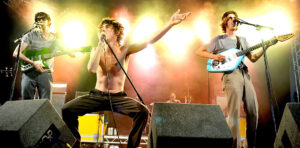When the Teddy boys burst onto the scene at the start of the drab Fifties, they established the template for all subcultures to follow. There have always been ultra-loyal music fans of individual artists, but this was something else: a look, and a lifestyle. The pattern usually went something like this: establish a uniform, adopt a musical preference, stir up the media to a predictable frenzy (wittingly or unwittingly), be denounced in Parliament, endure hand-wringing editorials declaring that civilisation is about to collapse, and then gradually become yesterday’s news as the hysteria blows over. Oh and, most discreditably of all, be written off as old farts by a younger subculture who have stepped up to take your place in the firing line.
The original Teds were the pioneers, denounced from pulpits and by politicians as little more than a hooligan mob. Originating in Blitz-damaged working-class districts of London such as Elephant & Castle and the East End, they began dressing in the Edwardian-style: long, velvet-collared jackets, narrow trousers, flashy waistcoats and crepe-soled shoes. The loss of countless young men in the war meant that jobs were now plentiful even for 15-year-old school-leavers, who had spare cash to go dancing, to the cinema and to order custom-made Ted suits from local tailors. And when authentic US rock’n’roll first broke into the British charts in late 1954, the Teds embraced it wholeheartedly. But it was only a few years before they grew up, and the mods and rockers came in to take their place as the moral panic of the day.
From the Fifties through to the end of the Eighties, this informal system of creative destruction roughly held. But then something went wrong. Though certain styles have a vague Noughties aura, there is little to fundamentally distinguish the way a teenager of today might dress from in 2004, or even earlier. And music is now consumed and sought out in a radically different way. A friend of mine who has been a well-known goth DJ for some years, told me that he was recently spinning records at Slimelight in London, a fixture since 1987, the “world’s oldest dark scene club playing ebm, electro, goth, futurepop, dark techno & trance, industrial”. The description itself is a measure of how much music scenes have fragmented into micro-categories. A young person came up to the booth and requested some “rock” music: when he asked her to be more specific, it turned out that she couldn’t name a single group or even a song she might prefer. She even seemed unclear as to what exactly rock might be in the first place.
It’s the sort of thing to give an old NME rockist an aneurysm. But it also marks a fundamental cultural change from the 20th century, when the category of “genre” was a fierce battlefield. Even “fame” has become compartmentalised. In their day, the Rolling Stones and the Sex Pistols were catapulted onto the front pages of newspapers and broadcast into millions of homes. A pensioner in the Sixties would have heard of (and probably loathed) Mick Jagger. But in our own time, acts can rack up colossal download figures while remaining almost completely unknown to anyone outside their own particular fan base.
Someone my age knows exactly what it feels like to be swept up by the new wind of a subculture. In 1976, punk rock hit Britain with the first Ramones LP, followed a few months later by the debut singles by the Damned and the Sex Pistols. The music and the clothing seemed the logical heirs to the stripped-down Fifties rock’n’roll I already loved. In our part of the country, you couldn’t yet walk into a shop and buy a punk t-shirt — such things were still the preserve of McLaren and Westwood’s wildly overpriced Seditionaries shop. But simple things — straight jeans rather than flares, skinny ties, short, spiky hair, combined with a scattering of badges — were enough to mark you out as some kind of a punk. And these standards were strictly policed. One of the best bands of the era, The Only Ones, were heckled at early gigs by their own crowd, who yelled “flared trousers, flared trousers” at them in protest at their failure to toe the sartorial line.
By 1977, I was regularly walking the night-time streets of my home city, Portsmouth, in DIY ripped-up and stencilled clothing. You quickly became used to running the gauntlet of other youth tribes who felt duty-bound to criticise your tastes by the application of fists or boots. But I cared enough about the music that it seemed worth the risk. And the music itself was a liberation, the sounds that I heard on John Peel’s evening Radio One show, and read about in the NME, inspiring me to form a band with some friends and start playing live, frequenting some of the city’s less salubrious pubs. Yet the tabloid newspapers of the day did everything in their power to promote the idea that punk musicians were little more than violent oafs: Bernard Brook-Partridge, chairman of the Greater London Council, famously declared that “most of these groups would be vastly improved by sudden death”.
It was certainly an identity that many were willing to scrap for. I was one of around 50 Portsmouth teenagers who showed up in October 1977 to see X-Ray Spex. One particularly brazen punk had scrawled “I’m Glad Elvis Died” across his torn white t-shirt: this was a provocation too far, given that Presley had been gone less than a month. A sizeable contingent of local Teds were waiting outside the venue when the gig finished, looking for an excuse to give some punks a hiding. (I was never much good at sport, but I ran off pretty swiftly before things spilled over into violence.) The media delighted in these scenes, deliberately pitting one group of young people against another. At the height of the Queen’s official Jubilee celebrations that year, Ian Glover-James from the London Evening Standard, accompanied by a photographer, rounded up a group of second-generation Teds and followed them as they set off down the King’s Road looking for punks to attack:
“It has been going on for a month or more. Gangs of Teds, teenage imitators of the 1950s originals, on search and destroy missions looking for the enemy, driven by a bond of brotherhood and intolerance for anything more bizarre than themselves. Their motive? Over to the leader of the pack, 19-year-old Rockin’ Mick from Brockley: ‘We hate punks,’ he stated simply. ‘By Christmas they’ll be wiped out.’”
The streets are far from safe for young people now, with parts of big cities governed by the anonymous threat of random knife crime. But this sort of passionate, identitarian — almost sectarian — violence between subcultures has largely disappeared.
In 1979, hot on the heels of punk, young people looking for a scene could choose between three separate revivals that year: ska, rockabilly and mod. The turn of the decade brought the New Romantic movement, the psychobillies who combined rockabilly and punk, and the Goths, whose major bands were often products of the original Seventies punk scene. Yet by the early Nineties, despite the fondness of the music press for hanging labels like grunge, shoegazing or Britpop on certain bands, it had become ever more difficult to tell an individual’s taste in music simply from the way they looked. A sea of shapeless t-shirts with band logos ruled the day. Scenes blended into each other, and people who attended a Pulp gig one evening might go to a Cramps gig the following night, all wearing the same clothes.
Today, in the age of the big flat now, the era of the animal-print onesie, fashions may fluctuate but are no longer a signifier of cultural identity. And, if you do feel the need to walk around dressed up as a leather-and-studs punk rocker or Vlad the Impaler, it will probably just be assumed that you’re on a stag or hen night. So much of youth fashion in particular has stood still. One of the most common streetwear styles today dates from 1986, when the pioneering New York hip-hop outfit Run-DMC sang about “My Adidas”, leading to a lucrative sponsorship deal with that corporation. The group’s essential look of clothing, headgear and trainers would not seem out of place worn by later hip-hop performers or fans over the succeeding decades.
Musical taste itself has mutated, becoming more all-encompassing and less partisan as the internet gave access to a far greater array of recordings from all periods and cultures than ever before. In the Seventies, Britain could support five national music papers selling hundreds of thousands of copies each week. Now, even their names — Record Mirror, Disc — sound like anachronisms. Such cohesion and shared experiences slowly became a thing of the past with the great proliferation of terrestrial and satellite channels over the following decades, and with it, that sense of belonging which is essential to nurturing a subculture. Common ground has given way to individual choice, and no-one seems to think that you can bring down the monarchy by singing a song anymore.
My uncle was a teenage Teddy boy in the mid-Fifties, growing up in a council house in Slough. He had the clothes, the haircut and the textbook James Dean-Presley moody expression which he could put on for the cameras, even in my parents’ wedding photos. During my punk days, I once asked him whether he and his friends had run into difficulties from differently-dressed groups, and he said no, it was just the Teds, the vanguard of youth rebellion, against the straight society.
Today, instead of that binary division, there are a multitude of available identities to try on and discard at will, while social media and the need for “likes” and approval reward those who fit in rather than kick out at the system. Of course, the system itself has also long since mutated, and the spectacle of former would-be rock singer and guitarist Tony Blair inviting Noel Gallagher to Downing Street in 1997 only showed how far the old battlelines had been erased. The title of one of Noel’s songs famously referenced Angry Young Man John Osborne’s Look Back in Anger, the 1956 play that declared that “there aren’t any good brave causes left”. In our time, plenty of young people march in the streets and protest about everything from wars to climate change, but the flags they fly are social and political, and what unites them is the individual cause they are fighting for, rather than any subculture.
Disclaimer
Some of the posts we share are controversial and we do not necessarily agree with them in the whole extend. Sometimes we agree with the content or part of it but we do not agree with the narration or language. Nevertheless we find them somehow interesting, valuable and/or informative or we share them, because we strongly believe in freedom of speech, free press and journalism. We strongly encourage you to have a critical approach to all the content, do your own research and analysis to build your own opinion.
We would be glad to have your feedback.
Source: UnHerd Read the original article here: https://unherd.com/




